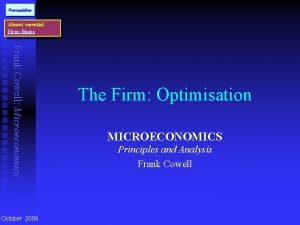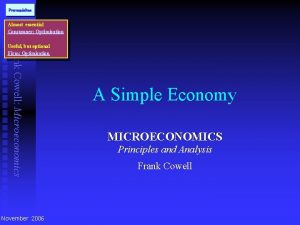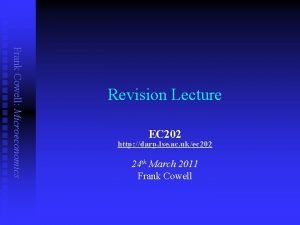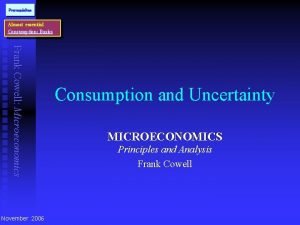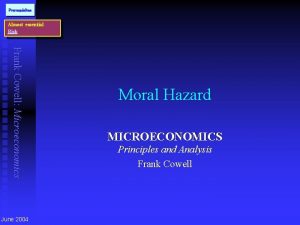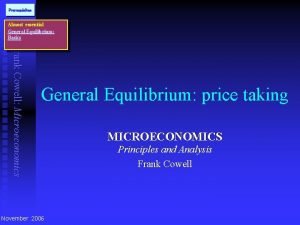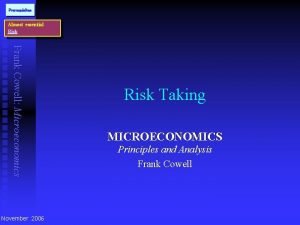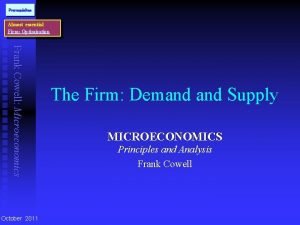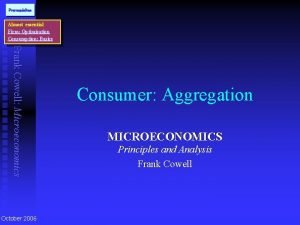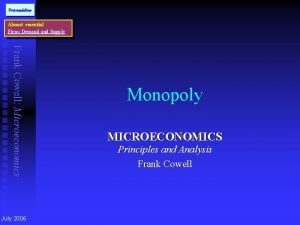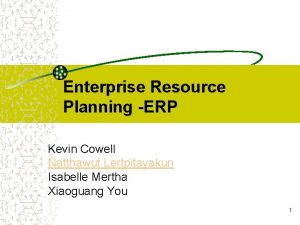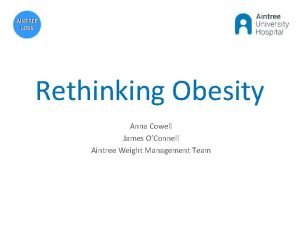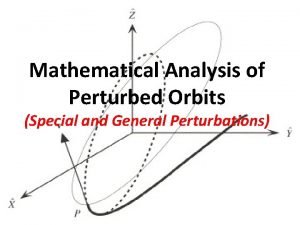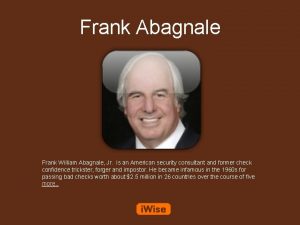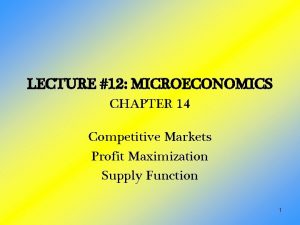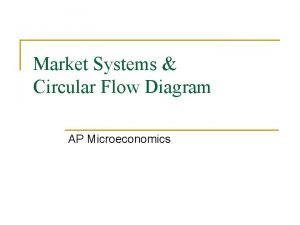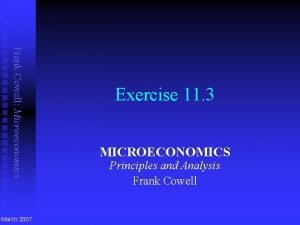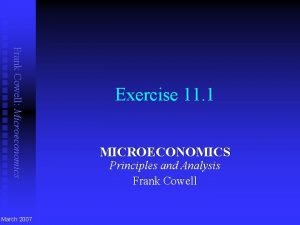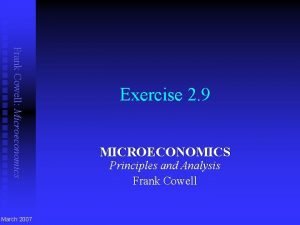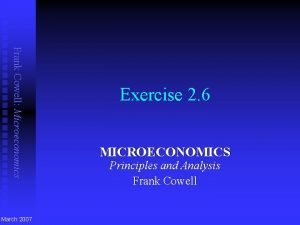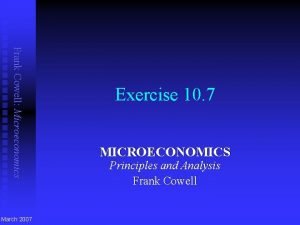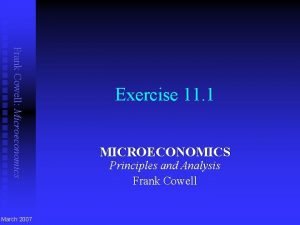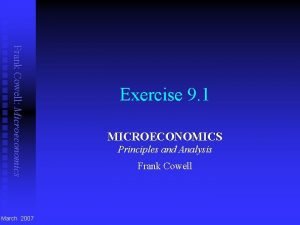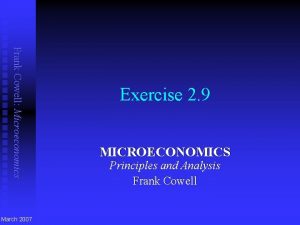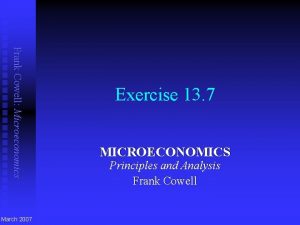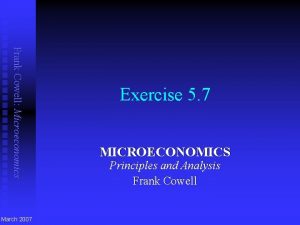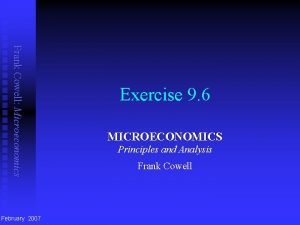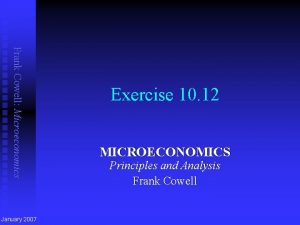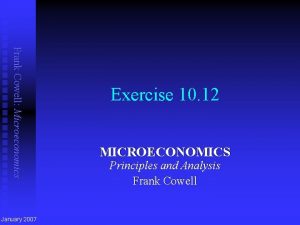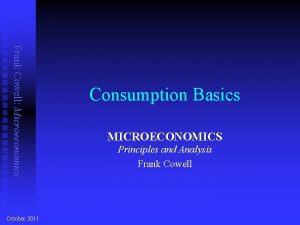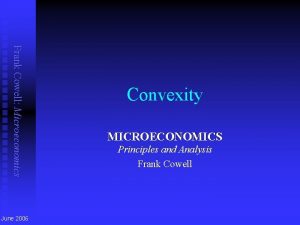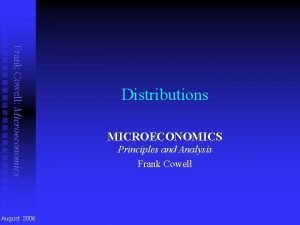Frank Cowell Microeconomics March 2007 Exercise 10 7

















- Slides: 17

Frank Cowell: Microeconomics March 2007 Exercise 10. 7 MICROECONOMICS Principles and Analysis Frank Cowell

Ex 10. 7(1): Question Frank Cowell: Microeconomics n n purpose: examine equilibrium concepts in a very simple duopoly method: determine best-response behaviour in a model where each firm takes other outputs as given

Ex 10. 7(1): iso-profit curve Frank Cowell: Microeconomics n By definition, profits of firm 2 are u u u n Price depends on total output in the industry u u n p = p(q 1 + q 2 ) = b 0 b[q 1 + q 2] So profits of firm 2 as a function of (q 1, q 2) are u n P 2 = pq 2 [C 0 + cq 2] where q 2 is the output of firm 2 C 0, c are parameters of the cost function P 2 = b 0 q 2 b[q 1 + q 2]q 2 [C 0 + cq 2] The iso-profit contour is found by u u setting P 2 as a constant plotting q 1 as a function of q 2

Ex 10. 7(1): firm 2’s iso-profit contours Frank Cowell: Microeconomics §Output space for the two firms §Contour for a given value of P §Contour map q 2 § b 0 q 2 b[q 1 + q 2]q 2 [C 0 + cq 2] = const § As q 1 falls for given q 2 price rises and firm 2’s profits rise prof it q 1

Ex 10. 7(2): Question Frank Cowell: Microeconomics method: n Use the result from part 1 n Use Cournot assumption to get firm 2’s best response to firm 1’s output (2’s reaction function) n By symmetry find the reaction function for firm 1 n Nash Equilibrium where both these functions are satisfied

Ex 10. 7(2): reaction functions and CNE Frank Cowell: Microeconomics n Firm 2 profits for given value`q of firm 1’s output: u n n Max this with respect to q 2 Differentiate to find FOC for a maximum: u n u q 2 = ½[b 0 c]/b ½`q 1 this is firm 2’s reaction function c 2 By symmetry, firm 1’s reaction function c 1 is u n b 0 b[`q 1 + 2 q 2] c = 0 Solve for firm 2’s output: u n P 2 = b 0 q 2 b[`q 1 + q 2 ]q 2 [C 0 + cq 2 ] q 1 = ½[ b 0 c]/ b ½ `q 2 Substitute back into c 2 to find Cournot-Nash solution u q 1 = q 2 = q. C = ⅓[b 0 c]/b

Ex 10. 7(2): firm 2’s reaction function Frank Cowell: Microeconomics §Output space as before §Isoprofit map for firm 2 §For given q 1 find q 2 to max 2’s profits §Repeat for other given values of q 1 §Plot locus of these points q 2 § Cournot assumption: § Each firm takes other’s output as prof it • • • given § Firm 2’s reaction function § c 2(q 1) gives firm 2’s best output c 2(∙) response to a given output q 1 of firm 1 q 1

Ex 10. 7(2): Cournot-Nash Frank Cowell: Microeconomics §Firm 2’s contours and reaction function §Firm 1’s contours §Firm 1’s reaction function §CN equilibrium at intersection q 2 c 1(∙) § c 1(q 2) gives firm 1’s best output response to a given output q 2 of firm 2 § Using the Cournot assumption… § …each firm is making best response q. C • to other exactly at q. C c 2(∙) q 1

Ex 10. 7(3): Question Frank Cowell: Microeconomics method: n Use reaction functions from part 2 n Find optimal output if one firm is a monopolist n Joint profit max is any output pair that sums to this monopolist output

Ex 10. 7(3): joint profits Frank Cowell: Microeconomics n n Total output is q = q 1 + q 2 The sum of the firms’ profits can be written as: u n Maximise this with respect to q u u n differentiate to find FOC for a maximum: b 0 2 bq c = 0 Solve for joint-profit maximising output: u n P 1 + P 2 = b 0 q 1 b[q 1 + q 2]q 1 [C 0 + cq 1] + b 0 q 2 b[q 1 + q 2]q 2 [C 0 + cq 2] = b 0 q b[q]2 [2 C 0 + cq] q = ½[b 0 c]/b However, breakdown into (q 1 , q 2) components is undefined

Ex 10. 7(3): Joint-profit max Frank Cowell: Microeconomics §Reaction functions of the two firms §Cournot-Nash equilibrium §Firm 1’s profit-max output if a monopolist §Firm 2’s profit-max output if a monopolist q 2 §Output combinations that max joint profit §Symmetric joint profit maximisation c 1(∙) (0, q. M) § q 1 + q 2 = q. M • q. C • § q. J = ½ q. M • q. J c 2(∙) • (q. M, 0) q 1

Ex 10. 7(4): Question Frank Cowell: Microeconomics method: n Use firm 2’s reaction function from part 2 (the “follower”) n Use this to determine opportunity set for firm 1 (the “leader”)

Ex 10. 7(4): reaction functions and CNE Frank Cowell: Microeconomics n Firm 2’s reaction function c 2: u n Firm 1 uses this reaction in its calculation of profit: u n n P 1 = b 0 q 1 b[q 1 + c 2(q 1)]q 1 [C 0 + cq 1] = b 0 q 1 b[q 1 + [½[b 0 c]/b ½q 1 ] ]q 1 [C 0 + cq 1] = ½[b 0 c bq 1] q 1 C 0 Max this with respect to q 1 Differentiate to find FOC for a maximum: u n q 2 = ½[b 0 c]/b ½q 1 ½[b 0 c ] bq 1 = 0 So, using firm 2’s reaction function again, Stackelberg outputs are u u q. S 1 = ½[b 0 c]/b (leader) q. S 2 = ¼[b 0 c]/b (follower)

Ex 10. 7(4): Stackelberg Frank Cowell: Microeconomics §Firm 2’s reaction function §Firm 1’s opportunity set §Firm 1’s profit-max using this set q 2 q. C • q. S of pr • it c 2(∙) • (q. M, 0) q 1

Ex 10. 7(5): Question Frank Cowell: Microeconomics method: n compute profit n plot in a diagram with (P 1 , P 2) on axes

Ex 10. 7(5): Possible payoffs Frank Cowell: Microeconomics P 2 §Profit space for the two firms §Attainable profits for two firms §Symmetric joint profit maximisation • (0, P ) M §max profits all to firm 1 (but with two firms present) §Monopoly profits (only one firm present) §Cournot profits §Stackelberg profits • § PJ = [b 0 c]2 /[8 b] C 0 § 2 PJ = [b 0 c]2 /[4 b] 2 C 0 (PJ, PJ) (PC, PC) • § PM = [b 0 c]2 /[4 b] C 0 § PC = [b 0 c]2 /[9 b] C 0 (PS 1, PS 2) § PS 1 = [b 0 c]2 /[8 b] C 0 { C 0 0 ° (P • , 0) M P 1 § PS 2 = [b 0 c]2 /[16 b] C 0

Ex 10. 7: Points to remember Frank Cowell: Microeconomics n n n Cournot best response embodied in c functions Cooperative solution found by treating firm as a monopolist Leader-Follower solution found by putting follower’s reaction into leader’s maximisation problem
 Almost essential
Almost essential Frank cowell
Frank cowell Cowell microeconomics
Cowell microeconomics Cowell microeconomics
Cowell microeconomics Almost essential
Almost essential Cowell microeconomics
Cowell microeconomics Cowell microeconomics
Cowell microeconomics Frank cowell
Frank cowell Frank cowell
Frank cowell Frank cowell
Frank cowell Anthem of poland
Anthem of poland Kevin cowell
Kevin cowell Aintree loss criteria
Aintree loss criteria Cowell's method
Cowell's method Cowell china
Cowell china Frank william abagnale, jr.
Frank william abagnale, jr. Microeconomics
Microeconomics Circulair flow marketing
Circulair flow marketing
